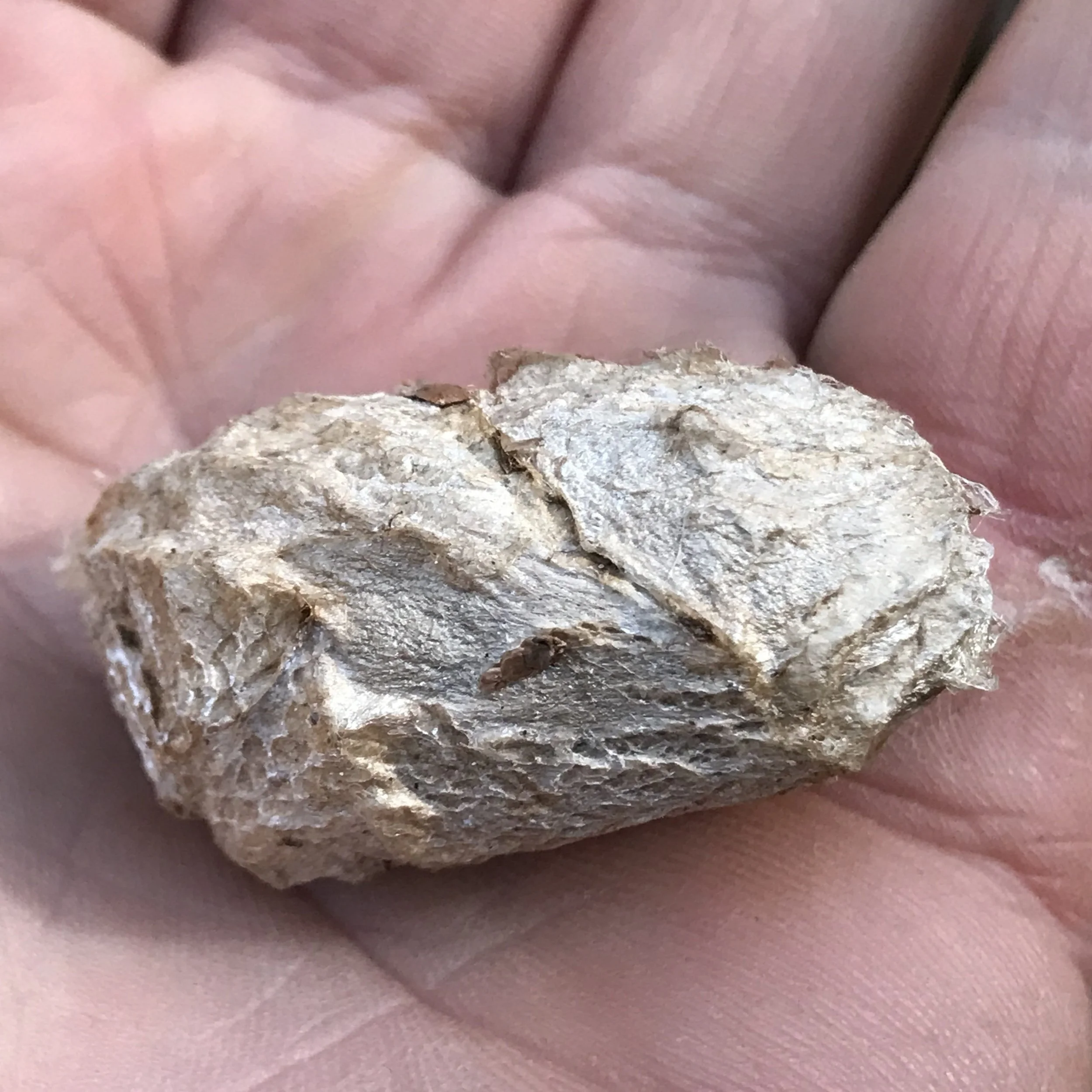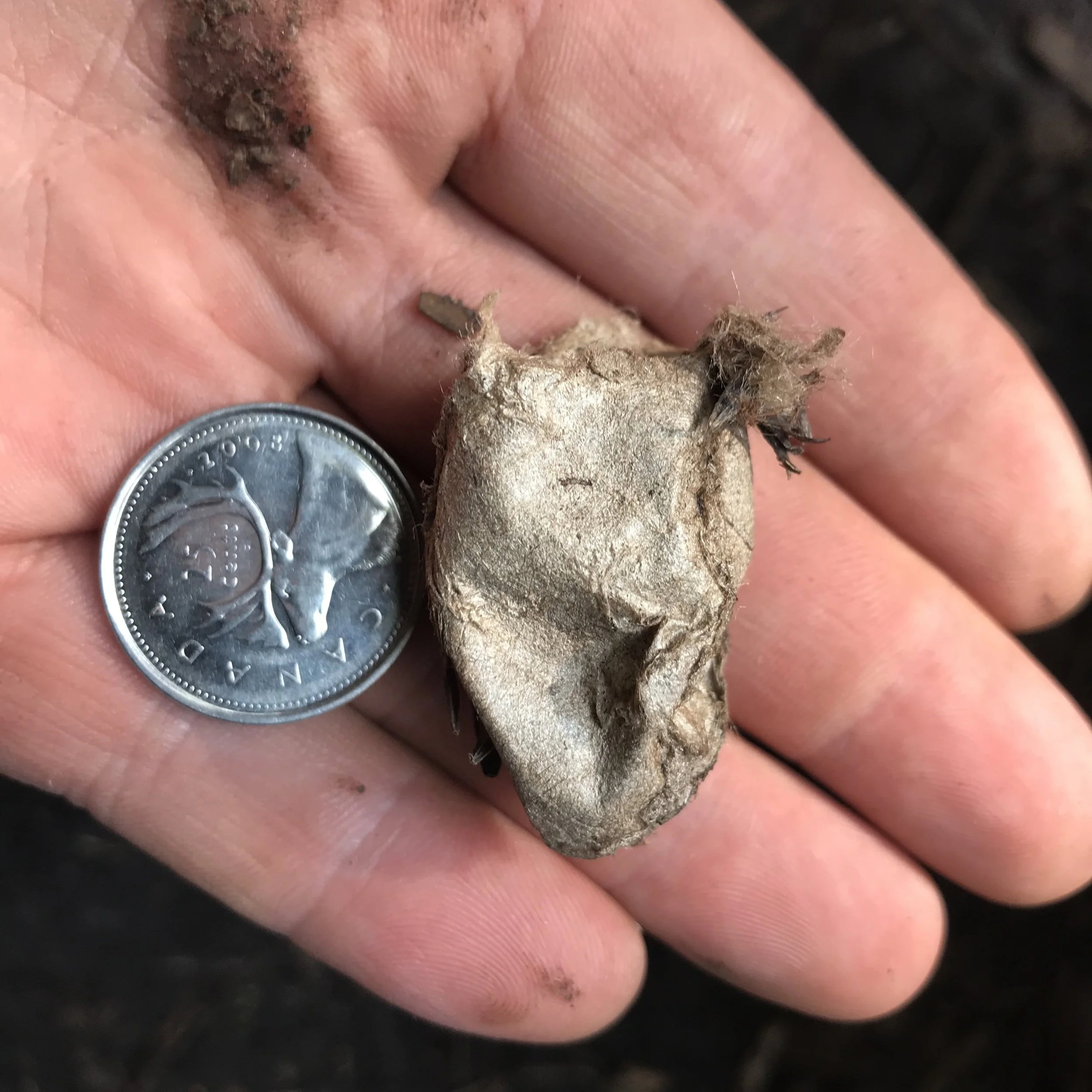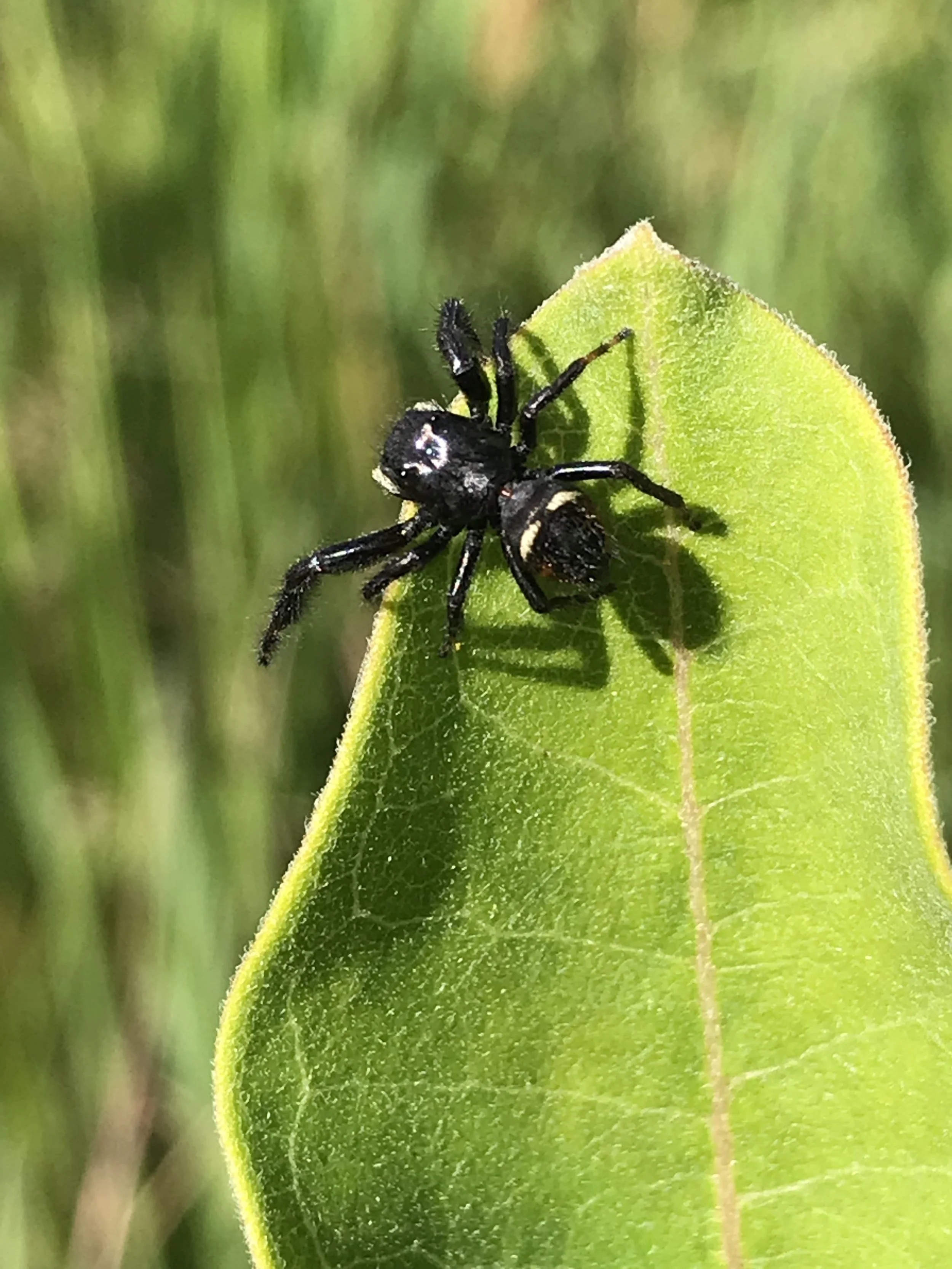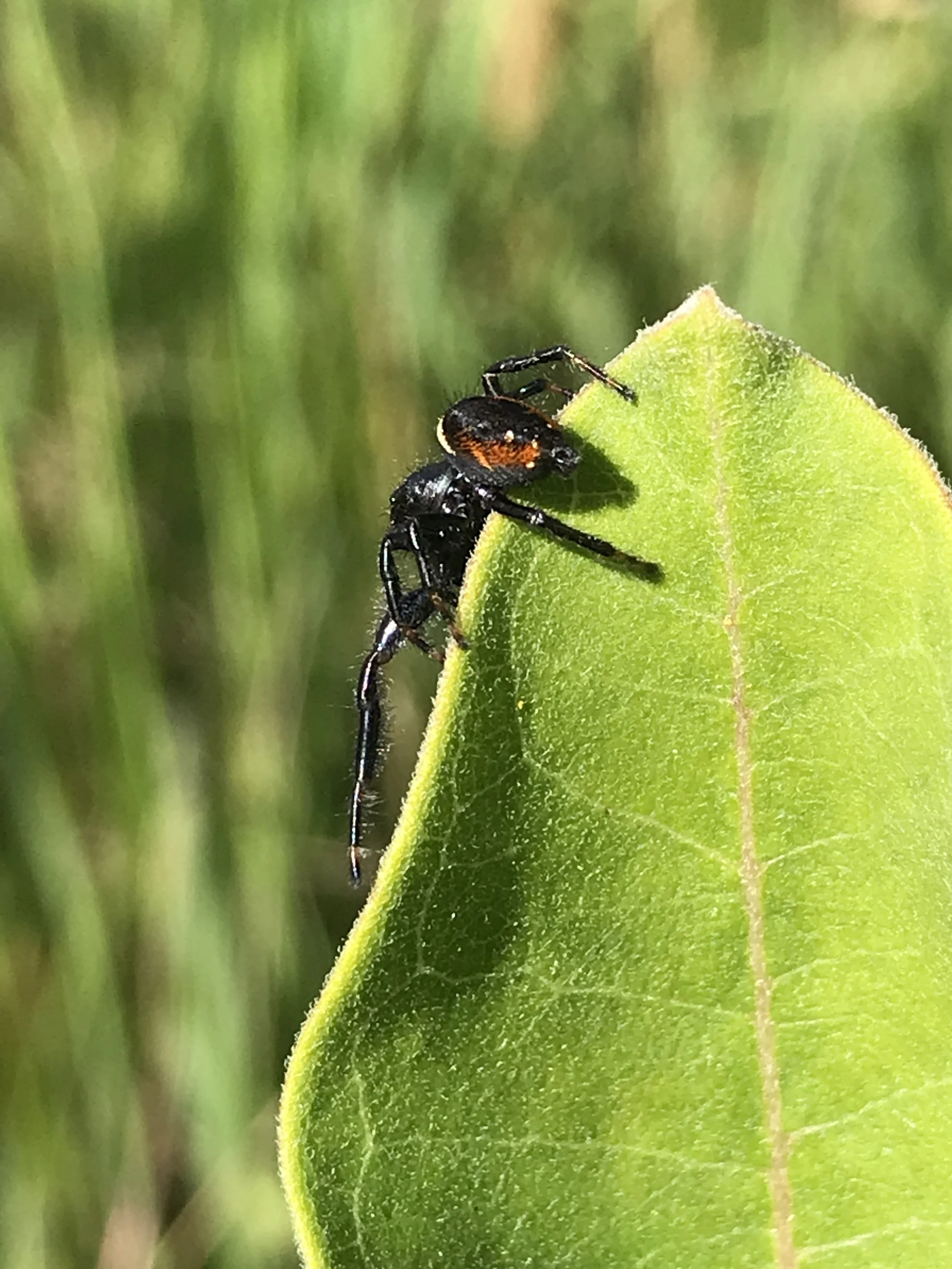Invert Sign at Dunby Rd.
Atop of a Common Milkweed (Asclepias syriaca) plant, on one of the highest leaves, we noticed a slight inward bend to the leaf, with a bit of webbing holding the opposite leaf edges closer together. When I leaned in to examine the leaf, a midsized spider emerged. They were hairy, striped and spotted. This spider had two darker lines going up the middle of her abdomen with white spots along them. I kept trying to reposition the leaf so I could get a photo of the spider’s face in hopes of counting the eyes and looking for the pedipalps (sensory appendages at the front of the spider) to see if this individual was a male or female. You can usually tell male or female based on the size of the pedipalps. I remember Chris Earley, naturalist at the University of Guelph Arboretum explaining once that the pedipalps on male spiders look like little boxing gloves held at the front of their faces, and I can really understand this image and helps to remember. This individual kept shifting their stance with every turn of the leaf under they eventually hopped down to the leaf before and I couldn’t see them anymore. Based on the hop, the size, and the way the spider held themselves, I guessed a jumping spider (Salticidae).
When I gave up on trying to find the spider who had hopped away I was gifted with another chance to examine a spider, as a second spider, slightly smaller than the first, emerged from the tangle of webbing at the base of the Milkweed leaf. This time the spider looked very different. This one appeared to be mostly black, with two white lines opposite each other in the middle of their abdomen. I also noticed two interesting red spots, or bands along the abdomen, and questioned, as I always do when I encounter any black spider with red colourations, if this was younger Northern Black Widow (Latrodectus variolus) before remembering that the Black Widows are much smoother, shinier spiders and through present, are rarely encountered in Southern Ontario. After a second, we could see that this black spider looked similar enough to the first, and I think a couple of us thought this too was a jumping spider. Soon this second spider jumped out of view. I examined the Milkweed a little longer and moved on.
It was only in my follow up research at home, checking the 2013 book Common Spiders of North American by Richard A Bradley that I learned that these two fairly distinct looking spiders were probably of the same species, the Brilliant Jumping Spider (Phidippus clarus), with the larger brownish one female, and the smaller black one, male. Brilliant Jumper is often found in old fields, open grassy areas, meadows, in all sorts of vegetation. This is exactly the habitat we found them in; a regenerating field, slowly being taken over by shrubs, some Scots and White Pine (Pinus sylvestris and P. strobus) and Trembling Aspen (Populus tremloides) . I really like thinking that if someone showed me a photo of a Brilliant Jumper I can then also imagine the habitat - the spider can be an associated sign of specific plant communities which would grow in these particular ecotones.
The silken construction, which was holding the folded in edges of the base of the Milkweed leaf is called a retreat. Many species of spiders create retreats and they are created for a variety of purposes including mating, protecting eggs, hibernating, resting, molting.. all really just hiding to avoid the detection of predators and/or waiting for prey to come by. Retreats can come in all sorts of shapes and forms, varying by species and may even show a great deal of diversity between retreats constructed by members of the same families. The retreats can be found the sides of human fabricated structures, or built on leaves, as the one above. Sometimes they are decorated with dead leaves, lichen, soil, and even body parts from the spiders dead prey. I know I’ll be looking for more Brilliant Jumper retreats now to see if I can sort out any common themes in their constructions.
As we slowly moved our way up a hill towards the woodland I stepped on a compacted pile of sand on the slope of the hill covered in grasses, Ragweed (Ambrosia artemisiifolia), Goldenrod (Solidago sp), and more. I looked down and saw that which I had just trampled, and just afterwards, I could smell them too.
These citronella ants are likely Lasius claviger, also known as the Common Citronella Ant or The Smaller Yellow Ant. Genus Lasius was formally known as the genera Acanthomyops. The “claviger” part of the name comes from “clavi”, which translates to “club” referencing their club-like antennae (“clavi” also informs the word “clover” to describe the common wildflowers in the Pea family). I have been known to eat a couple everytime I encounter them. I mentioned this to some of the folks present and a couple people tried tasting an ant. They are potently aromatic, with a citrusy, lemon verbena odour and taste which is quite pleasing. But I have never really known what causes this odour, and how the ants produce it. So I decided to look it up.
From my research, it seems like some members of the Lasius genus have enlarged mandibular gland located just inside the anterior portion of the head, which holds a lot of two very powerful citrus like compouds. One compound is citronellal, which is known to keep insects away in other contexts, which I wonder if aids in repelling would be parasites in the nest or wards off colonial invaders? Citronellal also acts as a antifungal agent, which would serve a species who mostly nest in soils, home to a myriad fungal hyphae. Citral another compound and is also found in some common plants such as Lemon Balm (Melissa officinalis), Lemon (Citrus limon), and Lemon Grass (Panicoideae subfamily). Citral is used in perfumery to enhance the lemony notes and also in flavouring of different foods.
Ants are very sensitive to chemical smells and pheromones and communicate extensively with these various compounds. I have read that the ants can share where food is by leaving a trail of scents excreted from their abdomen for other worker ants in the same colony to follow, while other chemicals can encourage ants to increase speed in their pace. In the case for Lasius ants, these powerful chemicals are likely being excreted as a chemical alarm call to alert other members of the nest when some alarm worthy event is happening, like when I stepped on the nest. Scents as alarm call is a pretty cool mechanism. I have been revisiting Eastern Chipmunk (Tamias striatus) alarm calls lately, such as their Chip! Chip! Chip! warning of ground predators, or their cluck, cluck, cluck warning of aerial predators. These auditory alarm calls alert us to the behaviours and movements of other animals on the landscape and is a form of tracking. Could we also then tune into our sense of smell as a powerful human tool to track our co-inhabitants? I believe we already do. We use scent to tell the difference between Coyote (Canis latrans), Fox (Vulpes vulpes), Porcupine (Erethizon dorsatum) and White-tailed Deer (Odocoileus virginiana) urine deposits. We can smell if a Striped Skunk (Mephitis mephitis) has sprayed recently. We can tell when fruits are ripe, or even the state of decomposition a body is in when we come across a dead animal on the land. Of course the citral and citronellal are a bit more subtle, but wouldn’t it be cool if we could smell the alarm given by the ants if a Common Shrew (Sorex cinereus) or Northern Flicker (Colaptes auratus) were to invade the ant nest? This is going in my list of tracking goals.
I still have an additional question about these compounds : how are these compounds produced in the mandibular glands? I still can’t sort that bit out. I am looking for the research, but my thought is that for researchers it is probably such a basic biological process that it doesn’t need to be covered in the literature. Maybe I’ll figure it out eventually.
We set off again, walking into the woods, exploring what we saw as we came to it. We checked out the scat of Ruffed Grouse (Bonasa umbellus) and Porcupine, a few different fungi and slime molds. Eventually as we were walking through to the tall mostly deciduous forest I got really stoked when I looked over and Diana was crouched down with some folks excitedly examining something on the forest floor. I had to figure out what they were all looking at.
A huge moth, a Silk Moth (Saturniidae family) to be a bit more accurate, was there nestled on top of the leaf litter just hanging out. Who were they? Were they resting? Hurt? It seemed like the moth was doing ok, but just chilling. I couldn’t identify the moth right away, but Diana did. Polyphemus Moth (Antheraea polyphemus). I took a closer look when I was photographing the moth (from a million different angles in case I missed anything) in hopes of learning to better i.d. a Polyphemus Moth in the future. The base colour of the moth is pale orangey brown, though sometimes can be pinkier, with transparent window (!!!) spots on both the forewings and hindwings. The windows on the hindwings are encircled by yellow, then black, and a touch of blue on the proximal side. I observed the antennae and realized that this was likely a female as the moth was larger and the antennae themselves were thinner and not as feathery or comb-like as males of many other moth species.
I was wondering if this female was going to be laying eggs soon, or if they had already? Polyphemus Moths, and all other Silk Moths actually, do not have mouths when they transform into adults, so perhaps this female was just tired from a short, but busy, adult life with no food and was just taking a rest on the forest floor. It won’t be a long rest though. The adults tend to only live for about four days. Turns out the Polyphemus females will emerge, quickly mate, lay tiny eggs that look like tiny chestnuts or maybe tiny hamburgers singly or paired, or even sometimes three together, and then die shortly afterwards. I read one page from the University of Waterloo where they observed a a Polyphemus moth lay 103 eggs in captivity between the dates of June 10-11 (1). I have read another website, this time the University of Michigan, where they write that a Polyphemus will only lay up to 5 eggs in a season (2). A blog (3)written by someone who raised a bunch of Polyphemus’ wrote that they can lay between 100 - 300 eggs. When I think to other insects and I get to wondering if the 103 number might be more accurate? Did UofMichigan mistake the number of eggs in a individual placement session? Maybe it varies with development of the caterpillar?
On the topic of different life stages of the Polyphemus, I wrote a short blog post on different Silk Moth cocoons, including the Polyphemus. Here is the entry on their cocoons :




Polyphemus Moth (Antheraea polyphemus)
Larval host plants : Ash, Birch, Cherry, Dogwood, Elm, Grape, Hickory, Maple, Oak, Pine, Rose, Willow.
Description of cocoon : Oval shaped, ~4.5 cm (1¾ in) usually spun with leaves in outer layer, though often found in the leaf litter. I have read and seen photographs of the cocoon dangling from a low branch similar to Promethea Moth cocoon. The silk is pale cream to white in colour until the caterpillar excretes a substance that toughens up the cocoon and changes the colour to a pale brown.
Notes : Woodlands and forests. Similar to Luna Moth (Actias luna) in size and shape though Polyphemus cocoon is thicker and more evenly oval and less squareish. Unlike other Saturniid moth cocoons, Polyphemus cocoon is entirely closed with no exit hole built in. Pupa will secrete an enzyme to help break down the cocoon when ready to emerge.
Now considering the Polyphemus and all I want to learn about them, I may try rearing them next year to see about observing and answering some of the remaining questions I have.
Learning more about invertebrates and the signs they leave behind is such a valuable part of wildlife tracking to me. I feel like when I teach or share about the inverts, most people are kind of “cool, but where are the mammals?” about it, but I hope to keep learning more so that I can inspire some deeper respect and awe about a couple whole other phylums (Arthropoda, Mullusca, Annelida, etc)! There is so much life out there, that doesn’t look like us, move like us, eat, excrete, breed or breathe like us and every time I learn something new I get stoked. I am grateful to get to share some of that excitement in this post.
To learn more :
Common Spiders of North American by Richard A Bradley. University of California Press, 2013.
Tracks and Sign of Insects and Other Invertebrates by Charley Eiseman and Noah Charney. Stackpole Books, 2010.
A Field Guide to the Ants of New England by Aaron M. Ellison, Nicholas J. Gotelli, Elizabeth J. Farnsworth and Gary D. Alpert. Yale Books, 2012.
The Complete Insect by David A. Grimaldi. Princeton University Press, 2023.
The Evolution of the Alarm-Defense System in the Formicine Ants by Edward O. Wilson and Fred E. Regnier, Jr. The American Naturalist, 1971.
The mandibular gland secretion of the ant, Myrmica scabrinodis by E. D. Morgan, M. R. Inwood, M.-C. Cammaerts. Physiological Entomology, 1978.
Antheraea polyphemus entry at University of Michigan’s Animal Diversity Web
Silk Moth blog by the University of Waterloo’s Ecology






